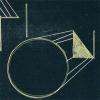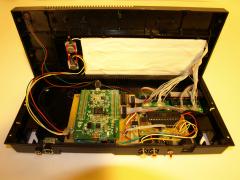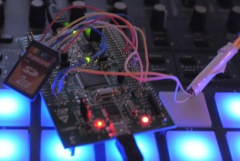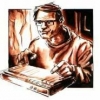Search the Community
Showing results for 'STM32F4'.
-
MBSEQ isn't a USB host device as well. This could become a feature of the STM32F4 based "MIDIbox SEQ V4 Plus", but it has low priority at my side (because I know that this will result into some remote troubleshooting for devices which I don't own by myself) Best Regards, Thorsten.
-
It's working now! But I noticed a strange behavior with the release phase of a sample: I always get a crispy/crackling sound when I release a key, no matter what I set the release parameter to. With no release phase (value 0) I just get a short klick (which I think is normal), but with longer release times (say up to 1000) the whole release phase of a sample is distorted/crackling. When I press a key till the sample ends everything is fine btw. I already tried different samples and different volumes, but the problem remains. I tried a LPC17 core with the sample player app a few months ago, and as far as I can remember there wasn't such a problem, but I'm not 100% sure. Could that be STM32F4-related? I could try my external DAC (TDA1543 based) that I used with the LPC17 if there is a way to connect that to the STM32F4.
-
Hi, many files have to be changed to support another STM32F4 derivative, especially when it's smaller (memory & package wise) than a STM32F407! Even for me this would take a couple of hours (therefore I can't give you simple instructions for the required changes). Most difficult topic is to decide the IO pin configuration for the reduced 64pin package. Many peripherals won't be available. However, since you already own a STM32F407, it's probably better to skip this idea anyhow. Best Regards, Thorsten.
-
"Time (and TK) heals all wounds" Just upgraded my YM- synth controller to MBNG on a STM32F4, where TK has integrated Radio Buttons, so now it works properly
-
From the album: eptheca
Upgraded from MB64 on Core8 to MBNG on STM32F4, for the Radio Button feature -
Hi, I m trying for the first time to use mios on a stm32f4..01that I missed purchased thinking that would be compatible with the bootloader and the app. Unfortunately it doesn't work as I expected and it seem the spec are different enough to create troubles. At the same time I purchased a real discovery one with the right ref stm32f407: so far so good it works for now the way it should. Could any one point me in the right Direction on how to update the sources to make the work with the mispurchased one? Just to let you know I m building a tr 808clone coming from microlarge website... And I intend to control it the mios. Thanks again
-
Hallo MIDI Freunde! ich bin gerade dabei einen einfachen MIDI-Router zu entwickeln. Im Forum habe ich schon einen MIDI-Router gesehen, der aber leider nicht meinen Ansprüchen genügt. Ich will Eingangssignale ohne PC auf verschiedene Ausgänge routen/mergen. Das Ganze soll mit einfachen Tastern und Encodern geschehen. Also ganz simpel ohne PC und Software. :phone: Um das Ganze abzurunden werde ich noch einen MIDI-Player/Recorder und einen Taktgeber integrieren. Im Anhang findet Ihr ein erstes Grobkonzept von mir. Als Basis werde ich einen STM32F4 verwenden. Soviel zu Therorie. Meine ersten Fragen an die Experten: - Gibt es solch einen MIDI-Router schon? - Ist dieses Vorhaben umsetzbar? C-Skillz und Elektronik Wissen sind vorhanden. - Welche freie Entwicklungsumgebung (Compiler + Debugger) empfehlt Ihr mir für den STM32F4? - Wie viele MIDI-Eingänge können maximal ohne Latenzprobleme auf einen Output gemerged werden (ohne SyEx)? Evtl. Erweiterung für bis zu 8 MIDI INs. Schönes Wochenende! Simple-MIDI-Router.pdf
-
Hey, I have a problem getting the Sample Player to work with the new STM32F4. I uploaded the project.hex and connected my sdcard with some samples, and they seem to load fine, BUT I can't hear anything?! When I connect my headphones I can hear a bit of white noise after the application is loaded, so that tells me that the audio out is (somehow?) initialized. My hardware config: - just the STM32F4-Discovery (no MBHP_CORE_STM32F4) with the additional jumper cable for 5V and an sdcard-reader directly connected - I tried two different sdcards, one 4gb with FAT32 (I know I should use FAT16) and one 4GB with 2x2GB FAT16 partitions - I know that these samples worked with a LPC17 based core - I tried uploading MB_NG and it also seems to work fine, also with the sdcard file browser - I connected the Audio-Out to headphones and to a mixer line-input as well, still nothing - according to MIOS Studio terminal output, everything is configured and loads up fine (see screenshots) What I am doing wrong? (If anybody wants to try my sdcard-files, they are here)
-

MB-LRE8x2CS rev 4.6 BULK ORDER spring 2014
Fairlightiii replied to Fairlightiii's topic in Bulk Orders
Hi Tom. Some answers: 8 with Midibox NG. MB-LRE8x2CS has notthing pre-assembled. If you want the LEDs already soldered, go for MB-LR4x2CS / MB-E4x2CS. Typically you can configure this to switch between the different modes (speed) of the encoder but you can assign any parameter to the command. Minimum: 1 core (any model: PIC, LPC17 or STM32F4 based core). In case you want to use the built-in switch of the encoders, you need to add a DINx2 module for each MB-LRE8x2CS. You can find the different Cores and the DIN modules in the SmashTV's shop. The faders and a AIN module (also in in the SmashTV's shop). You should consult the midibox page about the AIN module and use the search function of the forum to see if someone as already tried this type of use. Best regards, Jerome. -
I'm about to embark on a SEQ V4 as well and am wondering if there is a good resource or thread for reading up on how this project has changed in recent months due to updated hardware options. From reading another thread in this forum I see that the makers of the LPCXpresso board have made a revision such that the LPCXpresso and the MBHP_CORE_LPC17 board don't fit together nicely without some modification. Other threads are mentioning that a faster board with some better features, the STM32F4 is able to be used with the SEQ V4 project. Are other comments in this thread correct that SmashTV will be selling a revised version of the front panel board eventually? Would it be wise to start working on a SEQ V4 at this point or is waiting a few months until some of these newer revisions show themselves a better option?
-
From the album: Tutorial
low cost STM32F4 MIDI Player Erster Erfolg mit dem Tutorial #019: A MIDI Player plays from SD Card© Elektrophantasten
-
Empfehlung: Auf neuen STM32F4 MIDIbox core warten - http://ucapps.de/mbhp_core_stm32f4.html Standard MIOS32 Toolchain verwenden - http://ucapps.de/mios32_c.html Ciao und viele Grüße, Peter
-
Kurze und knackige Antwort :) Bevor ich mit der Programmierung beginne noch eine Frage: Welche freie Entwicklungsumgebung (Compiler + Debugger) empfehlt Ihr mir für den STM32F4?
-
novski: did you see this? http://www.ucapps.de/mbhp/mbhp_lcd_ssd1306_alt_port__stm32f4.pdf ...J5/J10B? static u8 lcd_alt_pinning = 0; // alternative LCD pinning (e.g. for MIDIbox CV which accesses a CLCD at J15, and SSD1306 displays at J5/J28 (STM32F4: J5/J10B)) http://svnmios.midibox.org/filedetails.php?repname=svn.mios32&path=%2Ftrunk%2Fmodules%2Fapp_lcd%2Funiversal%2Fapp_lcd.c&rev=1937
-
Hi. Wondering if the Schematic of STM32F4 is still Prototype or just the Boardlayout has to be checked? Can someone confirm that the Schematic is out of beta-stadium? Thanks Novski
-
...if it has stored, it should work. i never came across that issue. i am using the stm32f4 at the moment, but i have used the lpc1769 before, both under windows7. maybe someone else can help ?? saving every pixel was the goal with the tiny font, which i have "designed" in excel. for my current project i will probably use the tiny font on a dogm128x64 display. if i get chance i will "design" an inverted version of the tiny font for my project as well. if you like the tiny-font, let me know, and i can update the mios-svn with the inverted tiny-font... mOnO
-
Hello ! I'm working on this stm32f4 discovery ,and soon I saw this on your homepage I fell in love with it and bought one. The bootloader and the mios software is already working , this was real easy . What I need is the Functions off this Midfile Optimizer 7 on a hardware midifile player. My Motif es Rack can receive over USB , on 32 Channels but for some reasen only 30 are supported. But thats not important for the Moment. The routings on this Rack for sounds on 3 Stereo Outputs follows with sysex messages . Also each voice off the Drumset can be adjusted and changed. Also Effects and the DSP can be edited . Just take look at this midifileoptimizer free demo , its perfect for this Rackmodul for a live party . At the moment I'm speculating over the outlook . Thanks for Reply !
-
Ha Kibosh, welkom bij de club. Midibox is erg leuk, wel een echte DIY club. Midibox vraagt een stuk meer van je skills dan kleine electronica-kits van Velleman, aan de andere kant ben ik geen pro en lukt het me ook steeds beter - heb ik wel ongeveer twee jaar voor nodig gehad.. Voor je project zou ik me eens in deze midibox onderdelen verdiepen, op ucapps.de 1. De Midibox-NG als platform. Gemaakt voor allerlei soorten controllers, super flexibel te configureren, en da's stukken prettiger dan hardcoding in C. 2. Voor de aansturing van motorized faders heb je de MF-NG module (kijk onder MB hardware platform) 3. Buttons en encoders sluit je aan op een DIN module. Met 126 encoders heb je al 252 DIN aansluitpunten in gebruik (8 DIN modules), da's aardig wat. Buttons zul je dat in een DIO-matrix kwijt moeten. 4. Ongetwijfeld komen er ook nog ledjes bij (bijvoorbeeld voor mute, solo enz), die gaan op DIN modules 5. Je gaat ook een SD kaart nodig hebben om je configuratie op te slaan en een clcd kan ook prettig zijn voor de visual feedback. Ableton ken ik niet, maar ik neem aan dat daar wel een midi protocol voor is wat je kunt uitpluizen. Daar moet je kunnen terugvinden hoe de aansturing in midisignalen gebeurt. Je moet waarschijnlijk de controller zelf gaan configureren, ik weet noet of er al een standaard Mackie protocol script is. Ik betwijfel of je het voor 500 euro gaat redden. Motorized faders zijn dacht ik ca 15 eur per stuk, encoders doen ook gauw 1 euro, je hebt ook aardig wat pcbtjes nodig van Smash TV (1x core, 8 x din, 4 x MF, douts), ic's, voetjes, kristallen, weerstanden, condensatoren ea (zie de orderlists bij de modules). En je hebt een ARM processor nodig, een LPCExpresso LPC1769 of de nieuwe STM32F4. Lcd's en sd card interfaces koop je het beste op ebay direct uit China. Reichelt heeft veel materiaal en redelijke verzendkosten, ook kun je bij mouser bestellen, die is voor wat grotere orders best goedkoop (boven de 65 euro geen verzendkosten). En je wilt vast ook een goeie behuizing hebben - dat wil ook snel in de papieren lopen. Je kunt natuurlijk rustig aan beginnen en eerst een basis controller bouwen: 1 core, 1 x 8 faders & knoppen & encoders. Dat houdt het overzichtelijk en de kosten laag. Of zelfs eerst alleen een core en wat experimenteren met de NG software.. Misschien kom jenog op idee"en hoe je met minder hardware hetzelfde doel kunt bereiken. Hopelijk heb je wat aan mijn tips, succes!
-
This sure looks like there is a STM32F4 PCB in the works....... :) Interesting!!
-
Since STM32F4 outputs the MIDI Tx signals in open drain mode, it makes sense to add a 1k pull-up resistor to this pin. Not relevant for the Tx output of LPC17, since there it's configured in push-pull mode (due to a hardware imperfection) Best Regards, Thorsten.
-
Did you also consider, that STM32F4 has already 4 MIDI OUT (and 4 MIDI IN) ports in conjunction with the two (upcoming) MBHP_MIDI_IO boards? (Ignore the RTP MIDI extension at the right side, and IIC MIDI at the left side...) This might be the best solution. :smile: Best Regards, Thorsten.
-
Theoretically it is possible to connect both AOUT_NG and QUAD IIC. The big question is what application are you going to run on the LPC17 for this? MB CV is PIC_Core and MB CV V2 is still in progress and the new STM32F4 is highly recommended for this. Looking at http://www.ucapps.de/midibox_cv_v2.html the DOUT option is available.
-
...it is correct, if you want to connect MIDI-Port1 (LPC) to MIDI-Port1 (STM32F4), so you should be able to receive midi with your lpc from the stm32 and receive with your stm32 from the lpc... mOnO
-

MIDIbox CV for controlling 2 x MS-20 clone filters
eptheca replied to eptheca's topic in Design Concepts
I have started building my dual MS 20 clone filter with MBCV V2. The STM32F4 Core with LCD, SCS and SD card is working. I will use 6 of the 8 CV channels from the AOUT for the two filters, and since I don't have any other CV equipment, I have cased it together. I am thinking about adding the 4 scopes and some buttons and encoders, but I am not sure if I will need it for just using the MBCV for filters (no gatescetc.) Does anybody have any suggestions? Will the scopes and encoders + buttons be "handy" anyway? Also the filters have pots for the CV inputs. Do I need these? http://midibox.org/forums/index.php?app=core&module=attach§ion=attach&attach_id=11113 I have never used any CV gear, so I'm a bit lost -
I added some new features today: - the Lemur panel has been overworked, so that global parameters (outside the CV groups) are now accessible with the "G" button at the right side. - added "Force To Scale", which can either be activated at the end of the CV output data streams, or "in between" by using the modulation matrix. The Force To Scale works like a Quantiser which allows to select the note values which should be played - all other notes are forced to the neighbored selected note: In this example: only D# will be played, all other notes are forced to D# In order to use Force-to-Scale, either push the "Force Scale" button in the Main panel, or select the "FTS" operator in the modulation matrix. - support for analog inputs: STM32F4 all 8 inputs at J5A and J5B, and LPC17 currently only J5B.A4 and J5B.A5 (since J5A is used for OLEDs) - later it will be possible to use J5A as well for people who don't use the OLEDs on a LPC17 core (again: there is no limitation for the STM32F4 core) AIN inputs can be selected as source in the modulation matrix. In addition, AIN inputs can be used as external gates, e.g. to trigger the LFOs and Envelopes. In order to activate this function, change to the main page and increase the "Ext. Gate Threshold" value at the left side, which defines the level at which the gate will be triggered. - the envelopes got new curves (Exp1, Exp1Inv, Exp2, Exp2Inv), and it's possible to select different curves for rising and falling ramps: (inspired from the Andromeda synth as demonstrated by Hawkeye! :smile: - the modulation matrix got an offset parameter to increase/decrease the modulation path output: Unfortunately these changes lead to incompatible patches. Since there aren't so many users yet, I haven't worked on a translator -> your old patches will be corrupted (in the ENV and MOD sections). If you don't mind, just delete the old banks with the MIOS Filebrowser (remove MBCV_B1.V2 ... MBCV_B4.V2) Thereafter enter "reset" in the MIOS Terminal so that new banks are created. Please also note, that the updated Lemur panel has to be used as well with the new firmware, otherwise the parameters are not correctly mapped. Best Regards, Thorsten.


